How Big Does a Black Knife Fish Get
Black Ghost Knifefish are very popular – they are a mesmerizing and elegant fish that will steal your heart in no time.
Advertisements
From ghost stories of tribes in South America to electrogenesis, this fish will be an entertaining conversation starter in your home.
This fish is almost an exception to the rules of nature.
It does not have any scales or fins and its tail looks like a rod.
Advertisements
Read on to find out more about keeping Black Ghost Knifefish in your aquarium, from their ideal tank conditions to feeding and the best tank companions.
Black Ghost Knifefish Facts & Overview
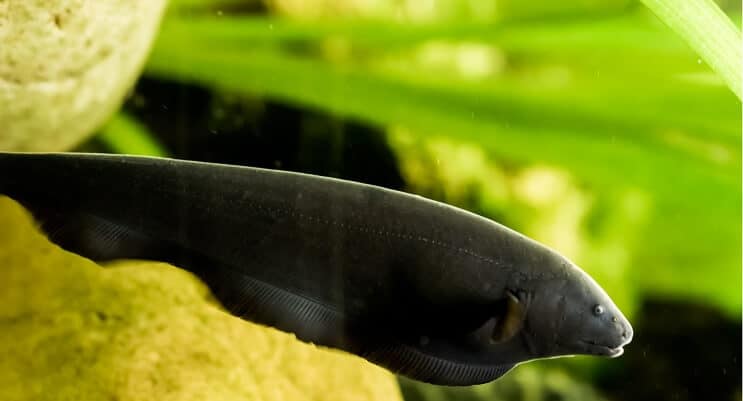
| Category | Rating |
| Care Level: | Intermediate |
| Temperament: | Semi-aggressive |
| Color Form: | Black and white |
| Lifespan: | 10-15 years |
| Size: | 20 inches |
| Diet: | Carnivore |
| Family: | Apteronotidae |
| Minimum Tank Size: | 100 gallons |
| Tank Set-Up: | Tropical-freshwater |
| Compatibility: | Medium size peaceful fish |
The Black Ghost Knifefish is one of the most popular Knifefish. It was originally known as Gymnotus albifrons and Apteronotus passan. But today this fish is known as Apteronotus albifrons.
Advertisements
Other common names which it is known by include the Apteronotid eel and the Black Knife.
An interesting story about this fish is one which is told by South American tribes. It is believed among the tribes that live in the Amazonian jungle, that the souls of the dead inhabit these fish.
The common name of this fish, the Ghost Knifefish comes from these stories.
Advertisements
These fish are mainly nocturnal animals and they use electrolocation to navigate dark waters.
This fish has quite a long lifespan and if cared for properly they will be your companion for 15 years.
It is readily available online or in pet shops for around $7.
Behavior
Black Ghost Knifefish are tropical freshwater fish from South America. These are nocturnal fish that are most active at night and rest during the day.
As they are most active at night, their eyesight is not well developed, so they hunt and communicate through an electric field.
They are quite shy and not very social preferring their own company – they can become quite aggressive if kept with other Knifefish. After they settle down in the new environment, they will come out from their hiding place during the night and swim mostly near the substrate or foliage and plants.
Appearance
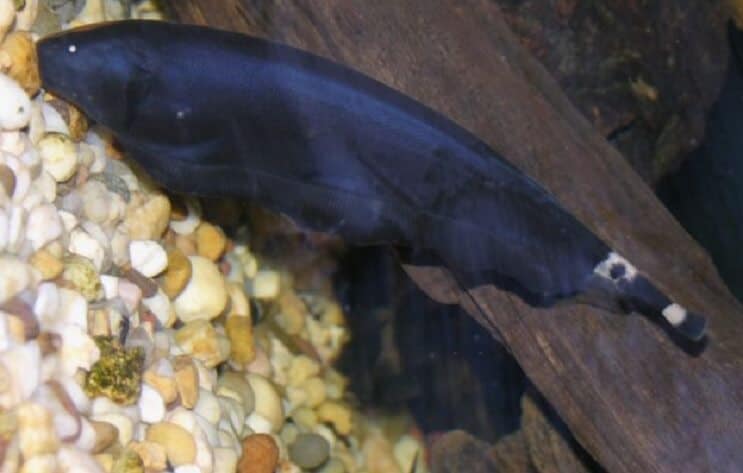
The Black Ghost Knifefish, as their name suggests, is entirely black except for two white rings on its tail and a white stripe on its nose that often extends along its back.
Unsurprisingly, it is also the shape of a knife – it has no caudal or dorsal fin.
Advertisements
Their body is flat and elongated, reaching up to 20 inches long when fully grown. The anal fin stretches along the body from the belly to the tail. This gives it an elegant swimming style.
This species of Knifefish does not have any scales. For this reason, this fish is very sensitive to water conditions and infections as it lacks the extra protection given by the scales.
Black Ghost Knifefish can both emit and receive electric signals. The electricity is produced by an organ found in the tail. These cells sit on the skin of the fish and are used for both communication and electrolocation.
This electrogenesis is interesting when looking at the differences between sexes. While there is no apparent dimorphism between the two sexes, it has been found that females emit higher frequencies than males.
Advertisements
Habitat and Tank Conditions
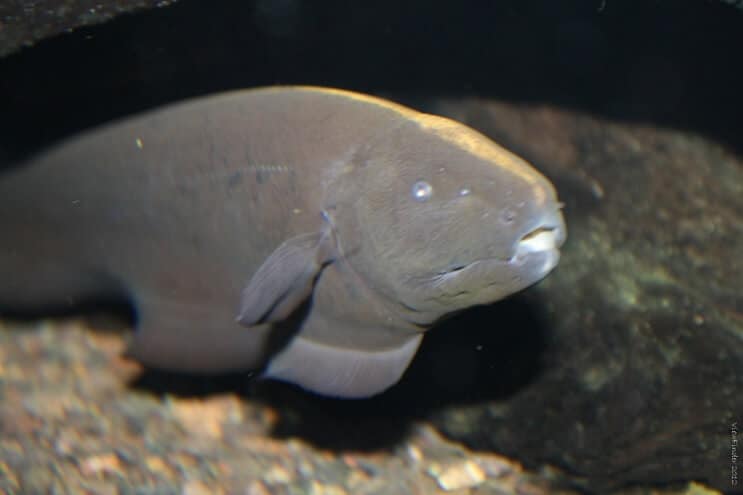
The Black Ghost Knifefish is found throughout the Amazon River and its tributaries, from Venezuela and Paraguay all the way down to the freshwater basins in Peru.
These waters are full of vegetation with plenty of nooks and crannies to hide. The waters are usually quite murky with low lighting and moderate water currents.
The water would also be warm with a fairly neutral pH.
The substrate beneath them would be soft sand that would not scratch, which is important since they are scaleless.
These tropical freshwater habitats are home to a wide variety of insects, which provide plenty of insect larvae for Black Ghost Knifefish to eat.
A captive Black Ghost Knifefish needs an environment that resembles their natural environment as closely as possible. This is simple to do, we outline how to below.
Tank Setup
As they are quite shy fish, they appreciate a tank with many hiding places. Smooth rocks and plants are must-have features for them in your aquarium.
Remember, this is a scaleless fish so you should provide a fine substrate to avoid injuries – use sand or a very fine gravel mix. The tank should have low lighting with a strong to moderate water current.
As the water in their natural environment is quite murky, they are tolerant to a range of water conditions. However, the best water parameters to allow your fish to easily settle are a temperature of 73.0-82.0°F, a pH range of 6.0-8.0, and a hardness of 5-19 dGH.
Black Ghost Knifefish are freshwater species and can not tolerate any brackish conditions.
Some hobbyists find their fish hiding in the canister filter or tubing. Make sure that when you are setting up the tank, use pre-filters or cover any open inlet tubes to avoid surprises.
Since they are scaleless fish and are prone to infections, a UV sterilizer is a good purchase to avoid complications as it helps to keep the water free of diseases.
What Size Aquarium Do They Need?
Black Ghost Knifefish are large fish and need a large aquarium of at least 100 gallons.
How Many Can Be Kept Per Gallon?
These are not an aggressive species toward other tank mates such as peaceful Cichlids, however, it becomes very aggressive when sharing small spaces with the same or similar species.
If you choose to keep these fish together, you will need to allow a minimum of 80 gallons per fish.
Tank Mates
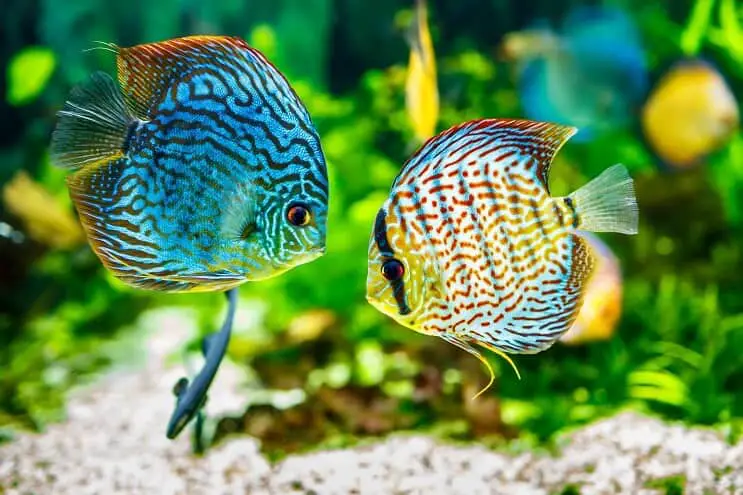
Even though they are considered semi-aggressive fish, they are perfect for a community aquarium.
The ideal community for this fish is other peaceful similar size fish such as peaceful Cichlids or Catfish.
Black Ghost Knifefish will start to become aggressive if they are limited to small spaces and if they don't have enough hiding spots.
Advertisements
They also become quite boisterous if kept with members of the same species or similar species.
Make sure any tank mates that you add are at least 6 inches in size and are quite peaceful.
The perfect community can be created using peaceful Catfish, Angelfish, large peaceful Cichlids, Discus and Corydoras.
Corydoras are great companions because they will also help keep the aquarium clean.
Tankmates will of course have to have similar preferences regarding the water conditions too. This rules out species like Goldfish which prefer cooler waters.
While your Black Ghost Knifefish is growing, you might be able to keep it with smaller size fish such as Tetras, Guppies, Barbs, and Rasboras.
Advertisements
Small crustaceans and gastropods (such as shrimps and snails) are not a good match as they are the perfect food for your Black Ghost. They will likely be eaten during night hours.
Don't keep these fish with other aggressive fish, or fish that are small enough to be considered food.
Keeping Black Ghost Knifefish Together
Keeping Black Ghost Knifefish together is not the best idea unless you can provide a tank large enough to let them establish and develop their own territory.
Care
Black Ghost Knifefish are recommended to more experienced aquarists as they can be challenging to keep.
This fish has no scales and is quite sensitive to diseases and chemicals in the water. This is why you might want to consider investing in a UV sterilizer.
Advertisements
One thing to keep in mind for this fish is to never use copper-based medicines as it is very toxic to them.
Knifefish are prone to skin flukes such as the Ich disease. Your fish will start to itch and rub themselves around the tank, however with the right treatment they should heal quickly. Raise the temperature up to 86°F if you spot any infection. Higher temperatures interrupt the parasite life cycle preventing reproduction and growth.
They are commercially bred in Indonesia which is great for the wild populations of South America.
When you are buying one, look at the size of it. If you get offered an individual bigger than 5 inches, it's likely to have come from the wild.
If an individual has come from the wild, it might carry parasites and diseases. Make sure you place them in quarantine to ensure no unwanted organisms enter your pristine aquarium.
Advertisements
Diet
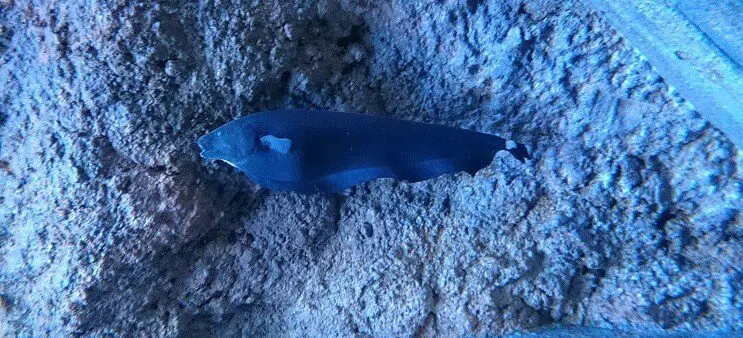
Black Ghost Knifefish are a carnivorous species. In the wild, they feed on insect larvae, juveniles, and small fish, and worms.
In your tank, this won't change much and they should be fed with fresh or frozen food such as bloodworms, brine shrimps, or blackworms.
Other alternatives are tubifex worms, krill, prawns, or crickets. You can also try to feed them pellets or flakes, however, it might take a while for them to get used to these.
They tend to avoid dry food.
It is important to keep a varied and balanced diet to ensure that your fish will receive the right vitamins and minerals for a healthy immune system.
They should be fed daily with an amount of food that they can eat in a few minutes. They are nocturnal animals and should be fed in the evening or at night.
Initially, they might struggle to feed. Black Ghosts are quite shy and will take a while to come out from hiding.
Some hobbyists have also been successful to feed their pets with their own hands. This might be something that you want to try, but you will have to be patient. It can take a while to train your fish, but it will be very rewarding.
Breeding
Black Ghost Knifefish are not commonly bred in tanks. Whilst there are claims from some hobbyists that they have managed to breed them, the methods are sometimes disputed.
Some specialized commercial fisheries in Indonesia have managed to breed them. However they are quite secretive about their success, so this still remains a mystery.
Advertisements
The most common factors to encourage breeding are:
- Large tanks (at least 100 gallons)
- Densely planted aquarium
- Lots of hiding places
- Flooding and draining the tank
Eggs are laid in a cave or a similar sheltered area. The eggs are yellow and about 0.08 inches in diameter; they usually take 3 days to hatch.
The parents should be separated from the eggs once they are laid. In the wild, it is common for the parent to eat the eggs; they do not appear to have any strong parental instincts.
Once the fry are released they will need to be fed a selection of small foods. These could be infusoria, baby brine shrimp, and/or broken-up flake foods.
Most aquarists do not reach the stage of raising Black Ghost Knifefish fry. If you manage it, may sure you share your story to help others and shed light on the mystery.
Advertisements
Summary
Black Ghost Knifefish are very popular, they have a mesmerizing swimming style and can be very friendly once settled in the tank.
Similar to most eels, Knifefish has an electro-sensory system used for location detection and communication.
As they are quite sensitive to diseases and can be a bit picky with food it is recommended that you gain some experience before keeping these fish.
This is a nocturnal fish and will be most active at night. They are carnivores and will mainly feed on worms, brine shrimps, and insects.
Over the years, aquarists have successfully trained their Knifefish to eat from their own hands – if you want to dedicate some time to this adventure, maybe you can get them eating from your hands too!
Advertisements
Have you already kept a Black Ghost Knifefish? Tell us about your experience in the comments section below…
How Big Does a Black Knife Fish Get
Source: https://www.fishkeepingworld.com/black-ghost-knifefish/